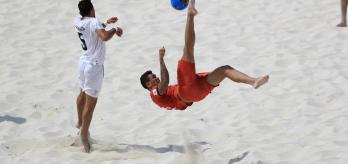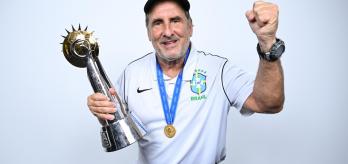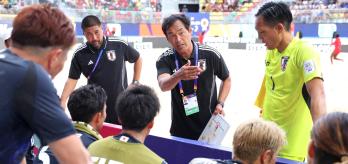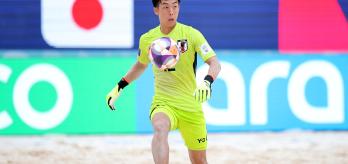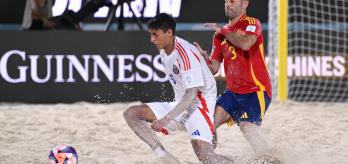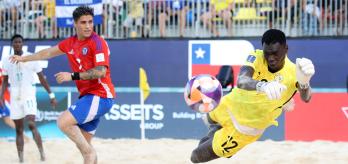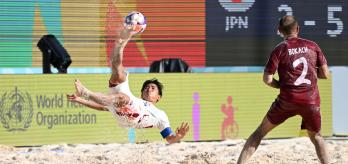In round one of FIFA Beach Soccer World Cup Seychelles 2025™, our Technical Study Group (TSG) enjoyed observing some of these aspects of forward play. In this article, they explain the components of these types of movements, highlighting their importance in the creation of goalscoring opportunities.
As TSG expert Angelo Schirinzi explains, “If a forward player can find space away from the defender which facilitates an action on their stronger side, this can be a key margin for success in such a fast, dynamic game. From a coaching perspective, having tactical strategies that can occur in direct play with a minimal number of passes can deceive the opposition because they happen so fast and provide limited opportunities for defenders to adjust.”
The ability to make decoy movements to create space is crucial for world-class forward players, as is possessing the game intelligence to occupy and come from positions outside of the line of sight of the nearest defenders. These attributes can give forwards real advantages in quick phases of the game.
In the clips below, Schirinzi and Matteo Marrucci highlight the impact that such movements and positional play have already had in the opening stages of this competition.
The movement by the forward to receive, in relation to the last defender
In clip 1 below, Italy start their build-up in 1-3-1 system with their two wide players dropping deep and wide to draw out Oman’s defenders and open the central space. Their forward, Alessandro Remedi (11), starts high behind the last defender, creating depth and space.
According to Schirinzi, “This move is all about timing, orientation and space. When Remedi sees that player in possession of the ball, Gianmarco Genovali (4) has a clear passing line, this triggers him to make the movement to receive. Genovali is aware of this movement and plays a straight ball forward. Remedi receives in the pivot position, using his body very well to protect the ball, and creates the opportunity for the diagonal run from deep by Tommaso Fazzini (10). As Remedi has attracted another defender, when he lays the ball off to Fazzini, there is space ahead of him to drive into before scoring a really well-worked goal.”
In clip 2, the movement by forward Takuya Akaguma (6) is triggered by the decoy offer to receive by left defender Takaaki Oba (7). Using the 1-3-1 system, Oba drops in when his goalkeeper Takeru Furusato (12) has the ball, bringing a Guatemala defender with him and opening space down the left channel. As this happens, Akaguma makes a subtle movement to the outside of Guatemala’s last defender before producing a decoy movement into the central channel and then checking back into Japan’s left attacking channel where the space is to receive, bringing the defender with him. This triggers a diagonal run from Oba. Simultaneously, goalkeeper Furusato expects this movement from his forward player because he waits to distribute the ball until Akaguma has started moving to the left channel. He then heads the ball across the goal, into the space created by his decoy movement, as Oba arrives to make an attempt at goal.
Marrucci explains, “Akaguma’s movement is like a basketball manoeuvre . This is a clever direct attack and is clearly a tactical move that Japan have worked on, with other players understanding the triggers for the movements, the run, and the distribution.”
Clip 3 is an example of a forward player’s movement triggering an attacking opportunity in the 1-2-2 system. As Artsemi Drozd (4) enters the pitch for Belarus, he positions himself very high in the left forward position, bringing the defender with him, while Anatoliy Ryabko (11) moves to the right, also dragging a defender out. This positioning creates space in front of Seychelles’ defensive line. When Drozd sees Mikita Chaikouski (5) in possession, he makes a movement to split the two defenders and creates space to receive the ball between the lines. Chaikouski anticipates this movement and plays a perfectly weighted flick pass onto Drozd’s chest, allowing him to set up the bicycle kick. The quality of this pass cannot be underestimated because it allows Drozd to tee up the bicycle kick with his first touch, meaning he is protected from contact by the defender, and scores a superb goal.
Good positioning by forward players to facilitate instinctive finishing
In these next three clips, Schirinzi and Marrucci highlight examples where the positioning of the forward players means they are in ideal locations to create goalscoring opportunities.
Clip 4 is from Oman’s opening game against Italy and comes from a direct attack. As soon as the goalkeeper, Younis Al Owaisi (12) receives the ball, forward Sami Al Bulushi (9) makes a forward run towards the central channel offering to receive the ball. The defender tracking him is looking towards the ball and therefore cannot see Al Bulushi as he positions himself behind the retreating defender. Al Owaisi throws the ball into the space just outside the defender, enabling Al Bulushi to cut across the back of the defender and score with a first-touch strike at goal using his strong (right) foot. The positioning here is excellent, and this facilitates the movement, but the quality of the finish from a tight angle is also superb.
Clip 5 is an example of clever positioning, instinctive forward player movement and incredible game awareness. As the ball is played back to Mauritania goalkeeper Abdoul Latif Sy (12), forward Cheikh Belkheir (7) advances into a high position in the final third, behind IR Iran’s defensive line. As soon as his goalkeeper receives the ball, he signals to receive on the outside, causing IR Iran defender Reza Amiri (3) to step out with him, opening space in the central channel. However, the goalkeeper opts not to play the pass and throws the ball down centrally. Immediately, Cheikh is now positioned unmarked behind IR Iran’s defensive line and outside of the line of sight of Amiri, the deepest defender. Sy strikes the ball straight towards IR Iran’s goal and defender Amiri attempts to intercept but does not make a connection. Cheikh anticipates the ball in this space and scores with an instinctive first touch.
Finally, clip 6 shows a goal being scored on a transition to attack and comes from the quick positional play triggered when Chile goalkeeper Pablo Rodríguez (12) receives the ball into his hands. Immediately, three players make forward runs towards the space in Tahiti’s half of the pitch. Crucially, as Diego San Martin (7) is teeing up for a bicycle kick attempt at goal, Sebastián Bolívar (3) takes a position at the front post and Diego Opazo (6) positions at the back post. Even though San Martin may score, Opazo fulfils his positional duties, and it is this commitment to his positional play that leads to him getting a goalscoring opportunity when San Martin’s attempt at goal drifts into his area.
Summary
In small-sided games like beach soccer, everything happens quickly. The explosive nature of the phases of play mean that space, timing and orientation are relentlessly crucial. Decisive gains can be achieved in split seconds, and therefore the movements and positions taken by forward players are intrinsic to the successes of attacking play. When these are coordinated with and understood by fellow teammates, match-winning moments can be created.




